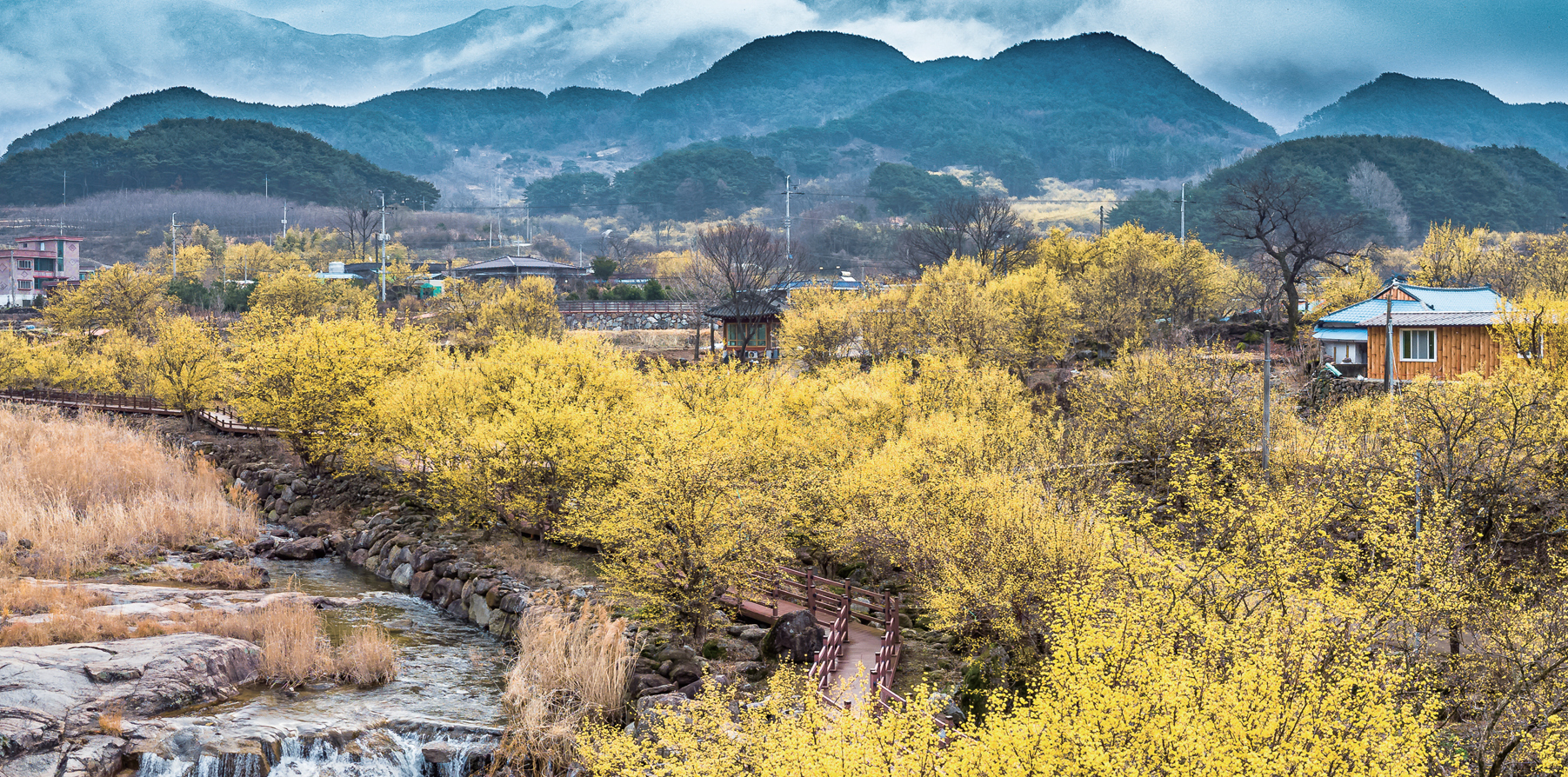Travel
Plums & Fruit Flowers
Gwangyang & Gurye
Jeollanam-do Province is renowned for its flowers. The mountain slopes of Gwangyang Maehwa Village light up with snowy plum blossoms, and magenta buds peek from Oknyongsa Temple Site Camellia Forest. In the vicinity, the yellow shade of cornus fruit flowers saturates Gurye Sansuyu Village — its valleys, streams and even village alleyways. Spring flora have overtaken the rural mountainside villages of Jirisan Mountain.
* Springtime scenery is an annual highlight in many parts of Korea. Amid the social distancing brought on by COVID-19, readers can experience through the magazine’s pages Korea’s season of blossoming.
Written & photographed by • Kim Hye Young
Spring’s arrival feels proper only once plum blossoms come out in Gwangyang Maehwa Village in Gwangyang, Jeollanamdo Province. After spending winter in what felt like a state of hibernation, I felt the time was ripe for plum blossoms. Instead of harvesting grains, villagers planted plum blossoms. The clear breeze and wet-fogged daybreak of the Seomjingang River created an ideal environment for the blossoms to flourish. As a result, the village arose as a beloved destination for natural flora.
At the breast of nearby Jirisan Mountain is an observatory offering a view of the silvery river and plum fields blanketing the mountain slope in its whiteness. As you head up, feast your eyes on the eclectic colors of plum blossoms that range from several shades of pink to white and green. A bounty of the blossoms is said to precede bountiful years for crop harvests; thus this year brings high hopes.
Upon reaching the observatory, a vista of sunlit plum blossoms unfolds underneath. The fantastic view makes you feel like you’re walking among clouds rather than uphill.
Cheong Maesil Farm

Director Im Kwon-taek’s film “Beyond the Years” used Gwangyang Maehwa Village as a set.
The highlight of the picturesque village is Cheong Maesil Farm. Located on Jirisan Mountain, this is Korea’s largest maesil (plum) farm. Multi-colored dried plums greet visitors from its entrance; the front garden is stocked with 2,000 crocks for fermenting and preserving paste and condiments. Each jar contains variations of maesil-based entrées such as maesil kimchi and concentrate or forms of pickled maesil including those containing chili or garlic.
This farm has been developed through five decades of toil by traditional food master Hong Ssang-ri. Smiling with the sweetness of plum blossoms, she continues to tend to the farm, clad in a casual Hanbok and a bamboo-braided hat.
The back of the farm leads to a bamboo forest trail. The river glistens between tall bamboo trees. Director Im Kwon-taek filmed his 2002 classic “Chihwaseon” (whose international title is “Painted Fire”) at this wondrous site, plus another of his films, “Beyond the Years,” at the thatch-roofed house. Poised at the center of the plum blossom garden, the picturesque home can be spotted from the observatory past the bamboo forest. The house provides another great lookout; its wooden porch yields a serene view of the garden’s lone plum blossom tree.
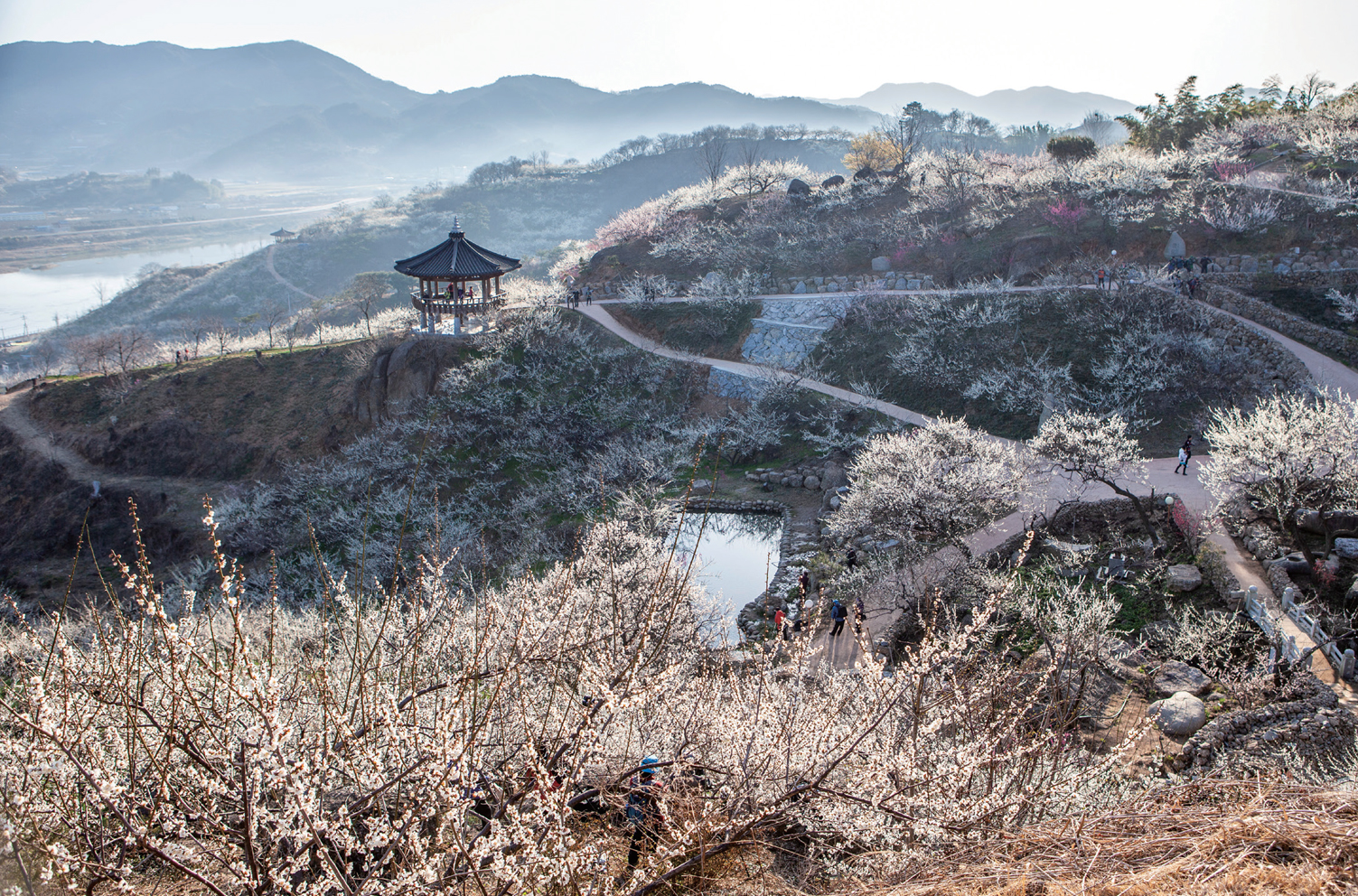
At the foot of Jirisan Mountain in the village are plum blossoms in full bloom.
Oknyongsa Temple Camellia Forest
Plum blossoms of the village bloom while camellias of Natural Monument No. 489, Okryongsa Camellia Forest, in the township of Okryong-myeon, Gwangyang, are in full bloom. Past the camellia tree tunnel at the forest’s entrance is Historic Site No. 407, Oknyongsaji (Oknyongsa Temple Site Camellia Forest). Situated atop a starry hill, the temple was restored by the Ven. Doseon, a Buddhist monk of the late unified Silla period who taught hundreds of pupils at the temple for 36 years. The only visible remnants of the temple today are the pillars’ bedrock giwa (an element for rooftop structures), a well and other fragments.
The camellia forest snugly embraces the temple site, which would otherwise look barren without the flowers. The monk is said to have cultivated the forest around a millennium ago to supplement the site’s ground energy. Around seven hectares in surface area, the forest features more than 10,000 camellia trees that are older than a century.
Camellias of the forest are the kind that bloom in springtime, dubbed choonbaek for their white color. They bloom from February to April, appearing in full bloom starting in mid-March. Camellias there tend to have small buds that don’t fully open even at full bloom. When a camellia fades, its entire flower head drops. On the soil, camellias bloom once more, saturating the trails.
Nothing beats the affection for camellias like the bird white-eye. Inhabiting the forest, white-eyes consume honey and transfer pollen the way bees do for other flowers. This year, the white-eyes seem especially enthused by the forest’s yields. They sing in unison, sounding like reed pipes.
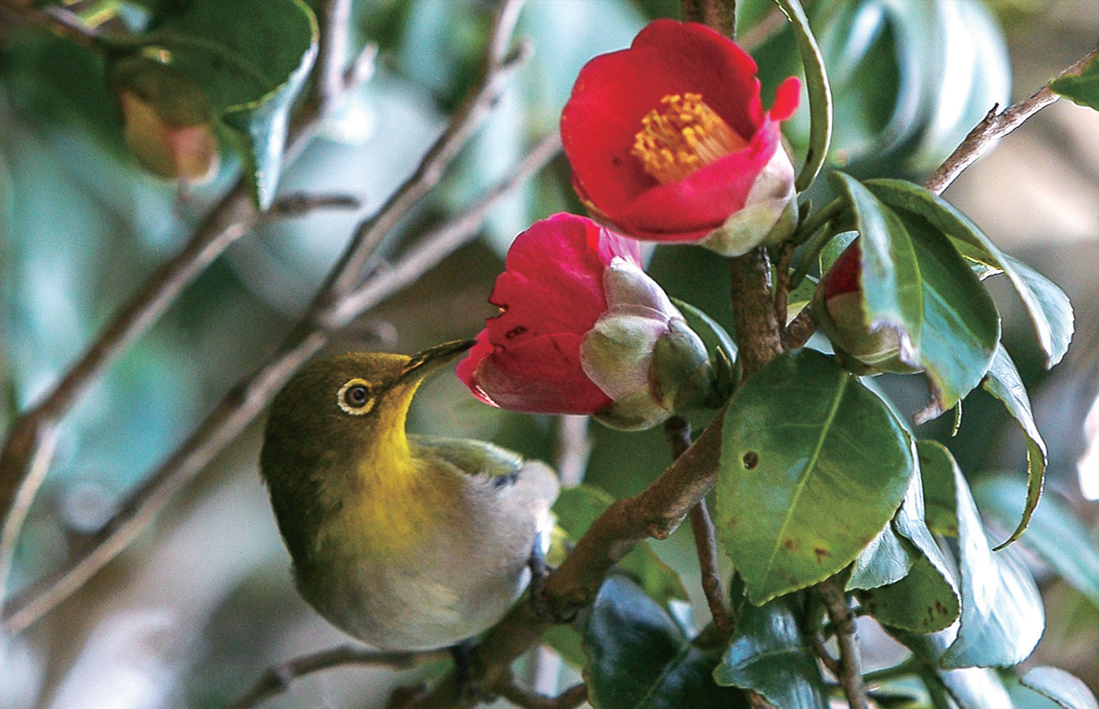
A white-eye sucks on camellia honey.
Gurye Sansuyu Village
About a 40-minute drive from the village is Gurye Sansuyu Village. The sansuyu (cornus fruit flower) is no less splendid than the plum blossoms of the neighboring Maehwa village. By mid-March, the township of Sandong-myeon is shrouded in the yellow hues of cornus fruit flowers. Prominent colonies of cornus fruit flowers preside in the villages of Daepyeong, Sangwe and Hyuncheon, the three of which comprise Gurye Sansuyu Village.
The cornus fruit flower colonies originated from Gyechuk Village, where Korea’s most aged cornus firewood resides. Buttressed by a thicker trunk, the trees from where the firewood originates are presumably older than 1,000 years, which their appearance reflects.
Daepyeong Village boasts the largest colony of cornus fruit flowers in the township. Its cornus trees line up to form a tunnel bordering the valley’s streams. Walking through the tunnel is pleasantly refreshing. In contrast to the plum blossoms’ aroma and elegance, the cornus fruit flowers boast bright colors.
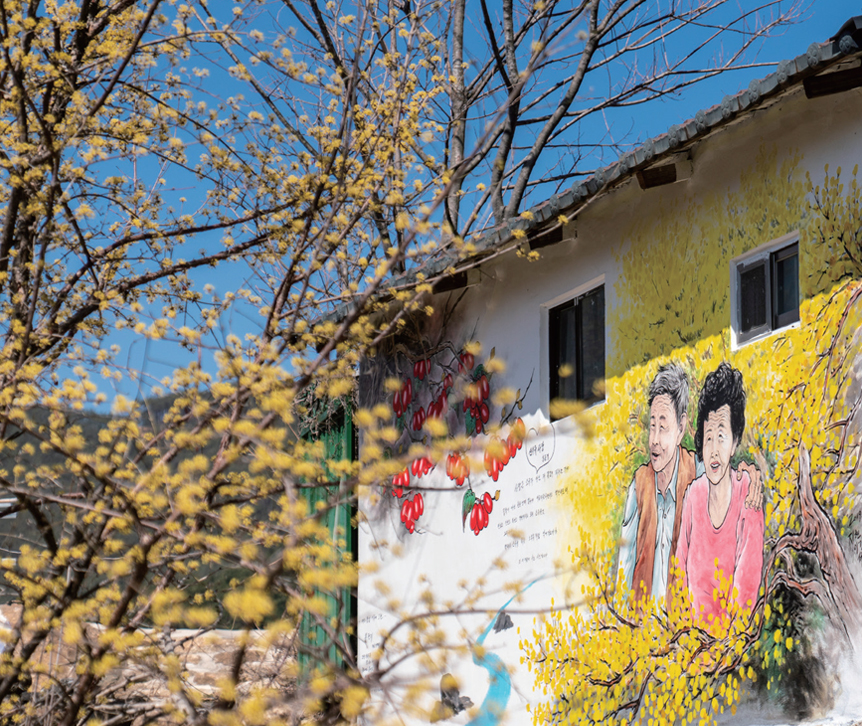
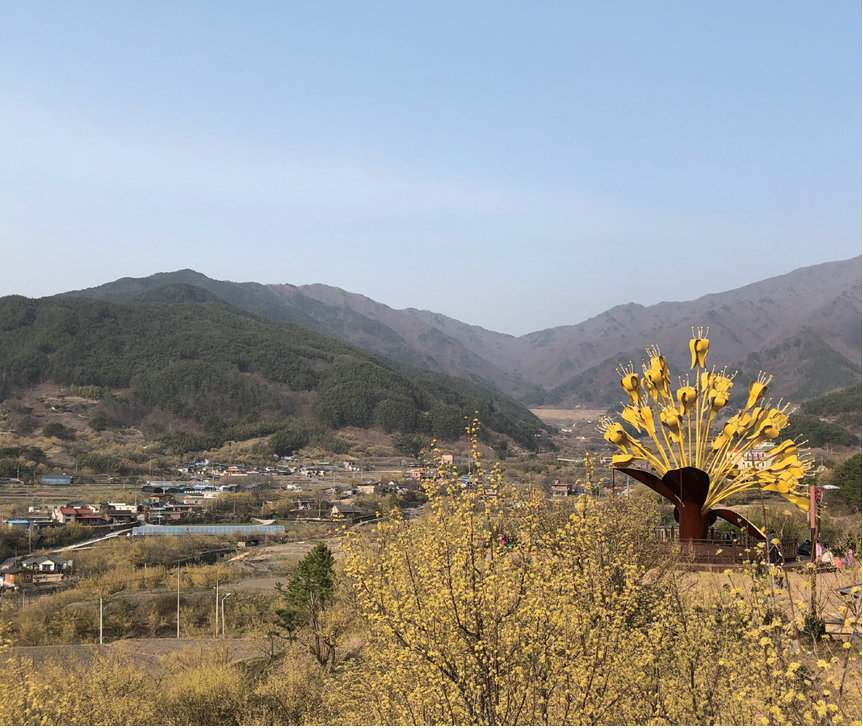
Wall paintings decorate the borders of Gurye Sansuyu Village. / A figure of cornus fruit flowers stands at Sansuyu Love Park in a village in Gurye-gun County, Jeollanam-do Province. © Gurye-gun County
Gurye Sansuyu Village’s charms peak at its valley streams and at cornus fruit flower colonies. The stone walls in Sangwe Village, like those of the Jeju Island specialty, naturally curve like the letter “s,” making people wonder what lies at the end of the trail. The stone-walled trail doesn’t feel long enough to satiate my appreciation of the walk.
Strolling around in the village are elderly women either selling or tending to cornus fruit flowers. The cornus flowers produced in this township account for greater than 60% of the nation’s output of the type. Villagers heat up, dissemble and dry these flowers to consume as tea or for use as medicine. As plum blossoms contribute to the regional economy, so do these flowers.
The small Hyuncheon Village is ideal for those seeking more tranquility in contrast to the tourist-thronged Sangwe or Daepyeong villages, with visitors able to stroll around Hyuncheon’s stone-walled perimeters in no time. As seen from other lookouts or reflected on the reservoir at its entrance, the village is a indeed stunning sight.

The rest area at Oknyongsa Temple Camellia Forest has a millennium-long history.
Other Articles
-

Story Hallowed History
-

Interview Han Bok-ryeo
-

Trends Food as Cultural Intermediary
-

Spotlight Heavenly Hansik
-

Travel Plums and Fruit Flowers
-

Flavor Cup bap
-

Culture Vulture Relaxing Retreat
-

Current Korea Global Benchmark in Fight vs.
COVID-19 -

Global Korea Fusion Gugak in Moscow
-

While in Korea Finding Housing
 Webzine
© KOCIS. All rights reserved.
Webzine
© KOCIS. All rights reserved.
